Queen Elizabeth: The London homes that made a monarch
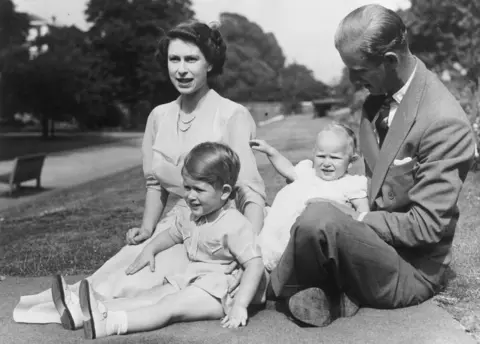 Getty Images
Getty ImagesMuch of Queen Elizabeth II's reign centred on London, not least because she spent much of her life living in and hosting events at Buckingham Palace.
The capital was also a constant feature of the Queen's formative years, with a number of different properties being homes for the then-princess.
Only one of these still exists, the others lost to war and redevelopment.
Where were these buildings and what part did they play in the making of a Queen?
17 Bruton Street, Mayfair
 Getty Images
Getty ImagesWhile many would assume a future Queen would enter the world in the most palatial of surroundings, Elizabeth Alexandra Mary Windsor was actually born in a townhouse in Bruton Street, in Mayfair, on 21 April 1926.
With its white Palladian front, the building just off Berkeley Square, stood out from those around it.
"It was described in the press as one of the most beautiful mansions in London," explains author Jane Dismore, whose books include Princess: The Early Life of Queen Elizabeth II.
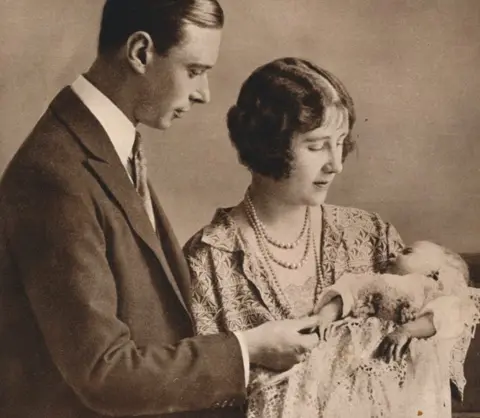 Getty Images
Getty ImagesBruton Street was one of the first roads to be developed on what had been farmland on the banks of the Tyburn River. The first homes there were completed in about 1740.
Number 17 was built in the following years. It was described as having a vaulted entrance hall and theatrical Rococo ceilings in the style of Isaac Ware, an architect who had been born a street urchin in 1704 but became famous for his grandiose style.
At the start of the 1920s it became the London home of the wealthy Earl and Countess of Strathmore and Kinghorne, the parents of Lady Elizabeth Bowes-Lyon, then Duchess of York.
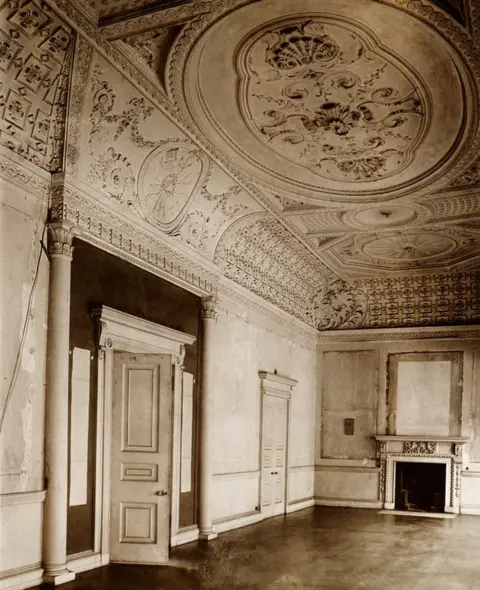 Historic England Archive
Historic England ArchiveAs the date of Elizabeth's birth approached it was decided that the duchess and her husband Albert, Duke of York - the future George VI - should have their first child in Bruton Street after the lease ran out on their previous house.
Princess Elizabeth was therefore born at the property, delivered by Caesarean section. Among those present was Home Secretary Sir William Joynson-Hicks, as was required for royal births at the time (the custom was eventually ended ahead of Prince Charles's birth in 1948).
Even so at that point the baby was not even destined to be Queen, her father being the second son of George V.
She was christened the following month by the Archbishop of York, Cosmo Gordon Lang, in the private chapel at Buckingham Palace. Her mother was photographed that day leaving the home in Bruton Street with her daughter as she made her way to the christening.
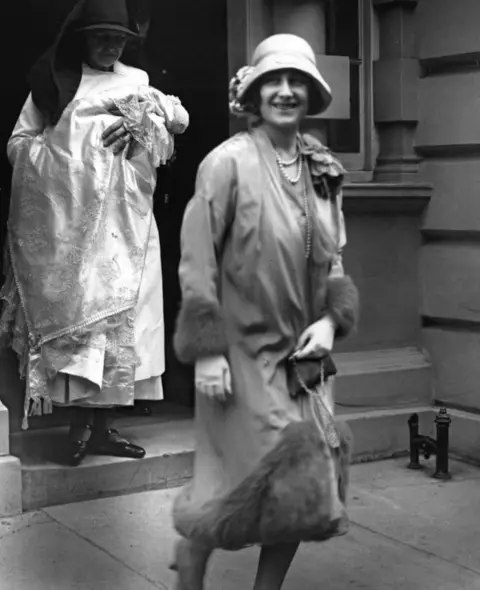 Getty Images
Getty ImagesThe family would continue living in number 17 at times over the following months while their next home was renovated.
In a letter sent from the duchess to her mother that October she wrote how "I honestly don't know what we would have done without it", before adding that "the baby is very well, and now spends the whole day taking her shoes off and sucking her toes!".
 Getty Images
Getty ImagesIt was also from Bruton Street where the nine-month-old princess waved off her parents in January 1927 as they left for a six-month tour of Australia and New Zealand, being held in her nanny's arms in one of the building's windows to do so.
"She wouldn't have remembered it but emotionally it was a significant place for the Queen," says Ms Dismore.
The house no longer exists. It was demolished in 1937 along with surrounding buildings to make way for Berkeley Square House, then considered to be one of Europe's largest office blocks.
 BBC
BBCThat building remains, housing various companies, restaurants and showrooms for high-end cars, like Bentley, Bugatti and Ferrari. The address 17 Bruton Street is used by a number of businesses including fashionable Chinese restaurant Hakkasan, which partly overlaps where the original home once stood.
Two plaques on the wall serve as reminders of the location where the Queen was born.
145 Piccadilly
 Getty Images
Getty ImagesThe duke and duchess got back to the UK in June and, now reunited with their daughter, moved into their new family home - 145 Piccadilly.
"It had its own balcony and as soon as the Yorks returned from their tour they stood on the balcony with Elizabeth in their arms and the public went wild," Ms Dismore says.
The property was a large terraced house, which faced south with a view over Green Park towards Buckingham Palace.
"One thing that always surprised me was there was no special security there. You could just walk up to the front door and there were two bells and one was for staff and one was for visitors," the royal biographer says.
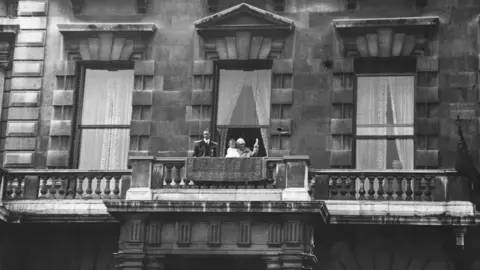 Getty Images
Getty ImagesAnyone walking through the entrance would have found a large hallway decorated with flowers and large green columns, with a brown carpet covering the floor.
"This led into a very airy morning room and that looked out on the family's garden where Elizabeth would ride her tricycle later on and beyond that was Hamilton Gardens - which was where she met her first best friend - and that directly led on to Hyde Park," Ms Dismore says.
There was also an electric lift, ballroom, library and 25 bedrooms, all beneath a large glass dome in the roof the building.
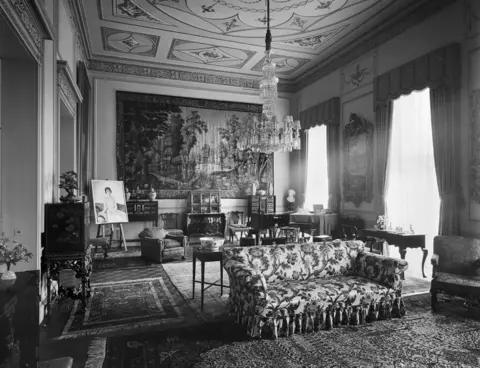 Historic England Archive
Historic England ArchivePrincess Elizabeth - or Lilibet as she was known because of the difficulty she had saying her own name - had a suite of rooms on the fourth floor of the house, which consisted of a day nursery, a night nursery and a bathroom. In 1930 she was joined there by her baby sister, Princess Margaret.
"In the day nursey there was a tall cabinet that had lots of toys and curios from all over the Empire and a lot of them were gifts from Queen Mary who loved all of her little miniatures," Ms Dismore says.
"One of the royal photographers, Lisa Sheridan, she said that she saw the princess (Elizabeth) crawling about and she was allowed to take out a teddy bear from one of the cupboards, but she was only allowed to play with one at a time, so once she finished with that toy it had to be put back."
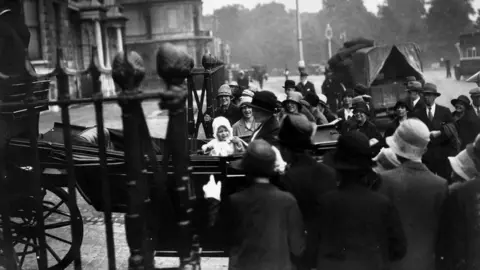 Getty Images
Getty ImagesWhile there were some staff, such as the princesses' nurse and nanny, the duke and duchess liked to keep numbers in the house to a minimum when there were no guests.
"They liked to live a private life without too many people around. Although they liked to socialise, when it came to shutting that door they liked to be fairly alone," Ms Dismore explains.
The couple would also enjoy spending time with their daughter, the duke regularly playing with Elizabeth before she went to bed, while the duchess taught her to read.
This was also a time when the many of the Queen's interests started to become apparent, including her association with her beloved corgis.
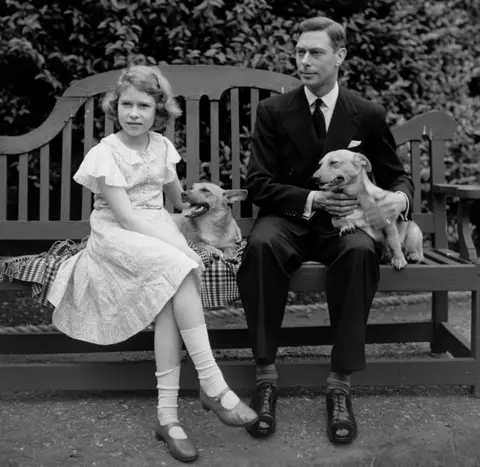 Getty Images
Getty ImagesIn 1933, the family acquired two dogs named Jane and Dookie at the request of the two princesses, the girls having enjoyed playing with a corgi owned by the children of the Marquess of Bath.
Princess Elizabeth's fondness for horses also emerged at this young age.
 Getty Images
Getty Images"Her grandparents, the Strathmores, had horses and I think that was probably where Elizabeth got her love of them from," Ms Dismore says.
The two princesses were educated at home in a schoolroom on the third floor by their governess Marion Crawford. She wrote in her book The Little Princesses she had "never known a house with a nicer atmosphere".
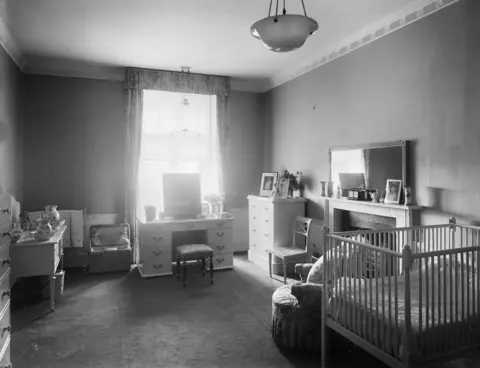 Historic England Archive
Historic England ArchiveBut that came to an abrupt halt in December 1936 following the abdication of Edward VIII.
Suddenly the family had to leave the comfort of their relatively small home to move to Buckingham Palace with its hundreds of rooms when Elizabeth's father Bertie became King George VI.
While attempts were made to give the princess some sense of normality, with a special Guides unit being set up in the palace and trips made on the Tube and bus, Elizabeth's new place as the heir presumptive meant life was now very different.
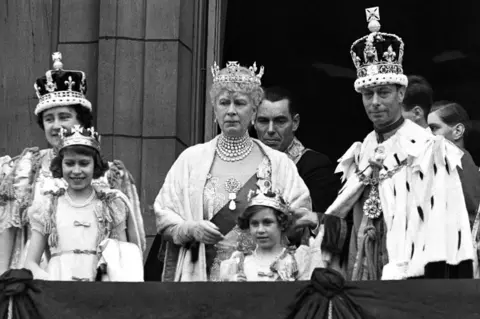 CORBIS/Getty Images
CORBIS/Getty Images"Things changed practically because her education became much more focused. By then she had her own security officer.
"Nothing was going to be normal after the abdication," Ms Dismore says.
The new king and queen remained at the palace during World War Two but Elizabeth and Margaret spent the majority of these years in Windsor Castle.
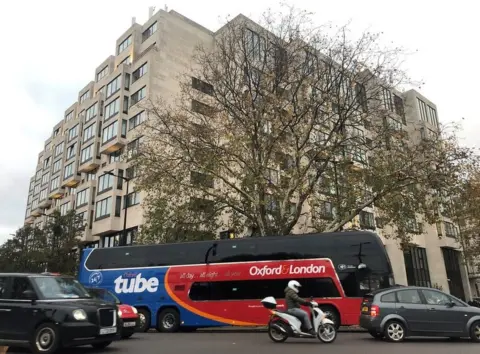 BBC
BBCAs for 145 Piccadilly, it was used as the chief office of the relief and comforts fund until on 7 October 1940 the house was badly damaged during an air raid.
It was then fully demolished in 1959 as part of a road improvement scheme for Hyde Park Corner. In its place was built the luxury hotel InterContinental London Park Lane, which opened in 1975 and remains to this day.
Clarence House
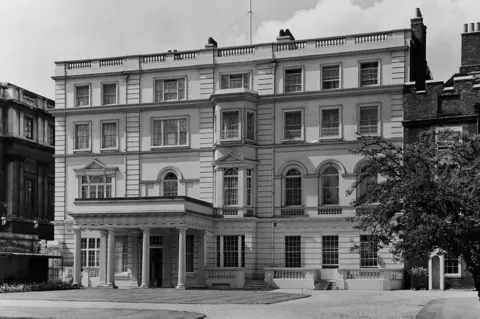 Getty Images
Getty ImagesClarence House has been used by royalty since 1827. It was designed by famed architect John Nash - who was also behind Regent's Park and Brighton Pavilion - for George III's third son, Prince William Henry, Duke of Clarence.
The building was handed to the newly married Princess Elizabeth and Prince Philip but because it suffered damage during the Blitz, they did not move in until 4 July 1949.
While it was being prepared, they stayed in an apartment in Kensington Palace with Elizabeth having offices in Buckingham Palace to carry out her work. This was where she gave birth to Prince Charles.
In the meantime Prince Philip took charge of refurbishing the new house. "Philip was very good at conducting things which are being done there because he was very good at design and Elizabeth was really not that bothered, she'd let him take charge," Ms Dismore says.
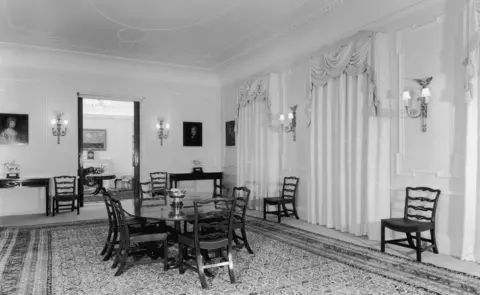 Getty Images
Getty ImagesMuch of the furniture used in the building came in the form of wedding presents. In the dining room was a Georgian dining table and 20 ladder-back chairs which were a gift from the Royal Warrant Holders Association, while a mahogany sideboard was a present from Queen Mary.
Ms Dismore describes the house as "pretty grand but it was not too big - it was manageable in the same way as 145 Piccadilly was manageable.
"Elizabeth and Philip lived very informally. Philip couldn't bear any sort of obsequiousness, he couldn't bear unnecessary formality and he liked things to be relaxed so he used to be very casual and walk in areas where it was staff only, carry his own luggage, all those sorts of things.
"They also didn't eat grandly and they would sometimes eat with staff," she adds.
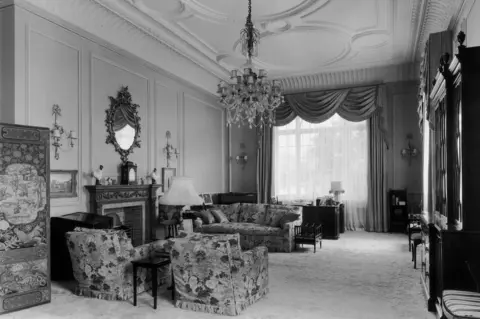 Getty Images
Getty ImagesThe couple would also spend time in Malta after Prince Philip was appointed second in command of HMS Chequers in 1949.
"Elizabeth would fly out at various times; she didn't stay there all the time because he had work to do and she had Prince Charles back home, but she would go out there as often as she could," Ms Dismore says.
The duke was able to take leave in 1950 for the birth of the couple's second child, Anne, who was born at their family home.
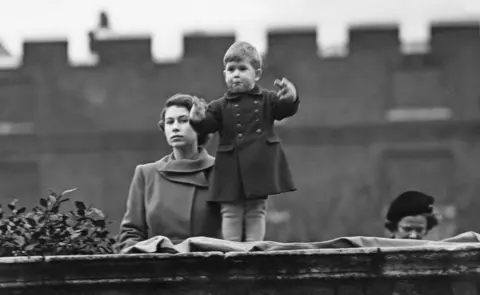 Getty Images
Getty ImagesNow settled into family life, the couple suddenly faced a seismic change. After embarking on a tour of the Commonwealth, Princess Elizabeth was informed of her father's death during a stopover in Kenya.
She had become the first English sovereign to succeed to the throne while abroad since George I more than 200 years before.
The family hoped to continue living at Clarence House, but Prime Minister Winston Churchill was opposed to this plan.
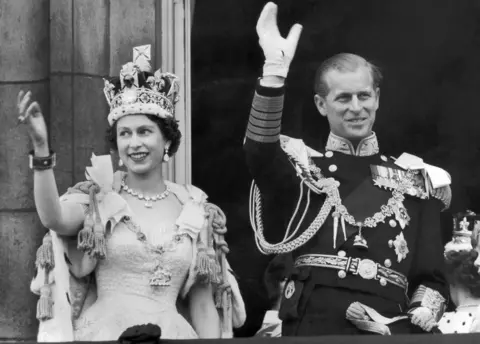 Getty Images
Getty ImagesAnd so Buckingham Palace again became Elizabeth's London residence, but this time with a very different life ahead of her.
"She had left England as a princess but came back as Queen," Ms Dismore says.
 BBC
BBCAll images subject to copyright
